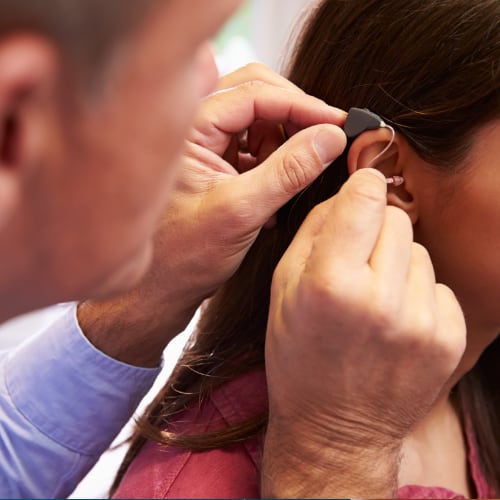 We live in an age that is referred to as the “Communication Era”. While all the five senses are important for human well-being, it is undeniable that the sense of hearing plays a dominant role in our ability to communicate and comprehend information. Hearing loss is a sudden or gradual decrease in the ability to hear and is very common. According to the National Institute on Deafness and Other Communication Disrders, 36 million Americans have a hearing loss. The severity of the loss can range from mild to profound. Hearing loss can impact anyone from infants to adults, and be caused by an exhastive number of causes, but it is usually due to a combination of genetic factors, aging and the accumulation of the effects of noise we have been exposed to throughout our lives. Hearing loss is now occurring in younger age groups due to a significant rise in recreational (iPods, cell phones, gaming) and environmental noise.
We live in an age that is referred to as the “Communication Era”. While all the five senses are important for human well-being, it is undeniable that the sense of hearing plays a dominant role in our ability to communicate and comprehend information. Hearing loss is a sudden or gradual decrease in the ability to hear and is very common. According to the National Institute on Deafness and Other Communication Disrders, 36 million Americans have a hearing loss. The severity of the loss can range from mild to profound. Hearing loss can impact anyone from infants to adults, and be caused by an exhastive number of causes, but it is usually due to a combination of genetic factors, aging and the accumulation of the effects of noise we have been exposed to throughout our lives. Hearing loss is now occurring in younger age groups due to a significant rise in recreational (iPods, cell phones, gaming) and environmental noise.
There are some very telling signs that a hearing loss may exist. Patients commonly complain about the inability to hear in the presence of background noise, they may turn the TV on too loud, have trouble listening clearly on a phone, ask their family to repeat things or they may miss parts of the conversation.
Studies have shown that hearing loss is associated with cognitive decline as we age. Lack of auditory stimulation leads to social isolation and a decline in the ability of the brain to receive and process sound. Treating hearing loss is likely the single most important thing one can do to try to prevent dementia.
NIH National Institute of Aging
Why Hearing Loss Could Be a Symptom of Cognitive Decline
The synergy between the physicians and audiologists at EARS Inc. is what sets us apart from other hearing aid centers. Our unique approach to patient care combines excellence in both disciplines and our patients enjoy having both of these services together in one convenient setting. Your evaluation begins with a thorough diagnostic audiogram performed by our licensed, doctorate audiologists or certified hearing aid specialists. An evaluation by one of the medical team members is then recommended to evaluate and counsel you with regards to the type, cause and prognosis of your hearing loss. Ear canal and wax problems are treated prior to obtaining a hearing aid. As many hearing conditions are surgically reversible, your treatment options will be outlined and reviewed. If a surgical procedure is possible to better improve your hearing, you will receive all the current information and options that exist to treat you, including investigative clinical trials.
If hearing aids are in your best interest, or what you prefer, the physicians, audiologists and hearing aid specialists will coordinate a treatment plan that will ensure a comfortable and successful hearing aid fit. You will be offered an appointment to meet with the audiology staff to discuss your hearing aid and assistive device options. The medical surveillance of your ears and hearing loss and your hearing aid progress will then continue together efficiently by our skilled team.
All hearing aids consist of the following components:
A microphone picks up the sound (acoustic energy) and converts it into an electrical signal. The amplifier amplifies this electrical signal before transmitting it to the reciever. The reciever gathers electrical signals from the amplifier and converts them back into acoustic energy and delievers the amplified sound to the ear.
The hearing aid evaluation is an appointment with one of our licensed hearing care professionals who specializes in hearing aids. The appointment is free of charge and you are under no obligation to purchase a hearing aid. Your appointment will be approximately one hour, and you are encouraged to bring a family member with you. We will evaluate your hearing needs, audiogram results, lifestyle, activities, manual dexterity, situations in which you are having difficulty hearing and your cosmetic concerns. These factors are considered with medical information such as the shape and health of your ear canal to make the best recommendations with respect to the technology and style of hearing device. You will have the opportunity to learn about the various hearing aids and assistive listening devices that may benefit you and all your questions will be answered.
Recommendations for hearing aids and price ranges will be reviewed. We will review several options for you to consider. Once you make a decision on the style of the hearing aid, we will make a custom-fit earmold, if needed.
Hearing aids take approximately two weeks to arrive, at which point you can schedule your first fitting appointment. It generally takes one to three appointments to fine-tune your hearing aids and make any required adjustments as you get used to the sounds of the world again. You will likely be amazed at what you've been missing! You have a 45 day trial period to decide if you want to keep your hearing aid(s).
Engineers and designers are partnering closely to develop hearing aids that not only improve hearing ability but are also visually appealing. Depending on the situation, a patient can choose from one of the five types of hearing aids listed below.
BTE hearing aids fit comfortably behind the ear and are attached to a custom earmold through a tube. They are suitable for all age groups. Because of their larger size, BTEs are very useful for patients with dexterity issues.

RITE/RIC hearing aids are similar to BTEs but the most important difference is that the receiver is placed in the ear canal. The sound quality is much smoother and free from distortion. Also the RITE casing is smaller than the regular BTE with regular tubing.
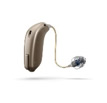
ITE hearing aids are more customized to suit individual patients and involve making an ear mold that completely fits the outer ear.
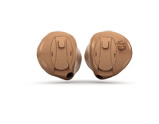
CIC's are the least noticeable hearing aids due to their small size. They fit entirely in the ear canal and are highly recommended for patients concerned with the visual appeal of wearing a hearing aid.
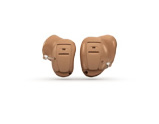
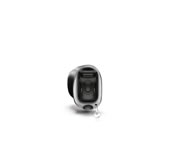
Hearing aids have advanced significantly over the past decade due the rapid development of the digital technology. Current hearing aids offer direct Bluetooth connection to your cell phone, apps to make hearing aid adjustments and rechargeable batteries. In addition, hearing aids are now better equipped to automatically adjust to the many different acoustic environments we live and work in while maintaining a cosmetically appealing size. To learn more how hearing aids can improve your hearing, please make an appointment.
CROS (Contralateral Routing of Signal) and BiCROS (a regular hearing aid on one ear and a CROS device on the other ear) hearing aids are an option for patients with single sided deafness, or patients who have useable hearing in only one ear. With a CROS hearing aid, sound from the poor ear is transmitted to the better hearing ear, allowing the patient to hear sounds presented to the poor side. With a BiCROS system, two devices are worn when the better ear also needs some amplification. In the poor ear, a transmitter sends sound that arrives to the the poor side to the better side where it is amplified.
Lyric is a disposable, continuous wear device that is placed in the ear canal by our professional staff without surgery or anesthesia. It is 100% invisible, very comfortable and care-free. It is the only hearing aid that can be worn continuously and is only removed to change the device when the battery fails, approximately every 2 months.

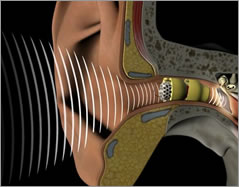
Bone conduction hearing aids are a wonderful option for patients with conductive or mixed hearing losses. No matter the cause of the conductive loss, hearing is usually better with a bone conduction device than with a conventional hearing aid as sound is more efficiently conducted to the inner ear and clarity is usually improved. These devices are also helpful to patients who cannot wear hearing aids due to medical problems in the ear canal and for patients with single sided deafness. We offer a variety of nonsurgical and surgical bone conductions devices and implants. The choice of the device depends on the patient’s age, health and degree of hearing loss. Nonsurgical devices are a treatment of choice in babies and young children or individuals who are not interested in or unable to undergo surgery, These devices can be worn on the head with the use of a Softband, SoundArc or an adhesive which sticks behind the ear.
This a nonsurgical bone conduction device which can be worn with an adhesive adaptor that is placed on the skin behind the ear. The ADHEAR system consists of the ADHEAR audio processor and the ADHEAR adaptor. The adaptor is a single use adhesive that can be worn for 3-7 days. The processor has dual microphones and can be connected to Bluetooth streamers and accessories. The ADHEAR processor is available in different colors.
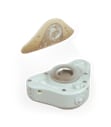
This device consists of the BAHA 5 or other bone conduction processor used in other implantable solutions adapted as a non-surgical bone conduction device by retaining it against the skull using either a Softband or SoundArc. This is an option sometimes used in children under the age of 5 or in adults who are not interested in surgery. Bone Conduction Impants
Conventional hearing aids use small speakers to amplify sound but speakers can amplify only a limited range of frequencies without causing distortion or feedback. Earlens is the only hearing aid solution that is placed in direct contact with the eardrum to transmit sound. As it directly vibrates the eardrum, it is able to amplify a broader range of low and high frequencies than conventional hearing aids. This expansion of the frequency range translates to a fuller, more natural sound experience and can improve speech understanding. The Earlens system uses a custom built lens that sits over the eardrum and is activated by small pulses of energy from the processor and custom ear tip. As it works without sound in the ear canal, feedback is eliminated.
In the fitting of the Earlens system, a patient works with a medical and audiology team to ensure that the best treatment possible. It is custom molded by an otologist in a painless process in our office. The lens is then manufactured, programmed by our PhD audiologists and then placed in the patient’s canal by the otologist. It is held in place through surface tension, similar to a contact lens in an eye.
Earlens utilizes wireless charging technology and has four customizable programs. It uses Bluetooth technology to connect to your iPhone.
Please call us to schedule an appointment with Dr. Maw or Dr. Inserra to discuss if you could be a candidate for this state-of-the-art hearing system.
The treatment of pediatric hearing loss requires special consideration. The dual evaluation and cooperation between medical physicians and audiologists is imperative in the diagnosis and treatment of hearing loss in babies and children. The professionals at EARS Inc. have extensive experience in the evaluation and management of hearing loss in children of all ages.
As babies and children grow, their anatomy and other conditions change. Behind-the-Ear (BTE) hearing aids are more durable and always recommended in babies and children due to the growing ear canal, safety and comfort. We use real ear measurements to ensure our pediatric population receives appropriate amplification in terms of gain and frequency from the hearing aid.
An assistive listening device (ALD) is a device that can help you to communicate better in your day-to day activities. Some of the ALDs are FM systems (frequency modulation systems), telephone amplified devices, amplified answering machines, computers, alarms, pocket talker and TV ears. Schedule an appointment for a consultation if you are interested.
An estimated 12.5% of children and 17% of adults have suffered permanent damage to their hearing from loud noise exposure. Noise induced hearing loss can be prevented by using custom molds in noisy environments such as sports and music venues. Custom earmolds can also be used to keep your ears dry during bathing and water activities if you have a medical condition that requires this. Please talk to one of our team members or make an appointment to discuss different custom ear mold options.
Please call us to schedule an appointment with Dr. Maw to discuss if you could be a candidate for this state-of-the-art procedure.